DNA testing can be an incredible resource for solving family history mysteries. For many, the thought of mastering this valuable tool can bring back haunting memories of high school chemistry and biology. Using DNA results can seem intimidating at first, but it doesn’t have to be. You don’t need to be a biologist or geneticist to effectively use your DNA test results to help build family trees and learn about your heritage.
This article is designed to give you an overview of how DNA can work for you, without getting bogged down in the math and science. The goal is to give you enough information to get started quickly and offer a foundation for learning more.
Let’s start with the basics –
Our bodies are made up of trillions of cells and each cell contains the DNA that makes us who we are. The way our bodies work, the color of our skin, eyes and hair are all coded into our DNA. Even though all humans are 99.9% the same, that .1% can vary substantially. With the exception of identical twins, which are almost (but not quite) identical, each person inherits unique DNA. Even between siblings, there are differences in what we inherit from our parents.
On average, we inherit about 50% of our DNA from our mothers and 50% from our fathers. It might help to think of the DNA we inherit from our parents as a bowl full of jellybeans in 22 different colors. When the bowls are mixed together to make you, the proportion of colors will be different than your mother and father. That is what makes you unique. When a brother or sister is born, the mix starts over, so the bowl that siblings get will be different than you and your parents.
This mix happens from generation to generation and it is pretty random. Those purple jellybeans your mother inherited from her great grandmother might make it into your bowl and it might not. Some could end up in your brother or sister’s bowl. This mixing of the bowls is called “recombination.”
The important thing to remember about recombination is that it is random. We don’t always get a proportional amount of DNA from each of our ancestors. For example, you might have a 3rd great-grandmother that was Native American. After five generations of recombination, you might not end up with any of her DNA. That doesn’t mean she isn’t your 3rd great-grandmother. It just means her DNA didn’t happen to make it to you.
DNA sounds like one thing but there are actually four different types of DNA that we use for genealogy. They are autosomal DNA (at-DNA), Y-DNA, mitochondrial DNA (mt-DNA) and X-DNA.
The figure below shows what this looks like in a typical cell
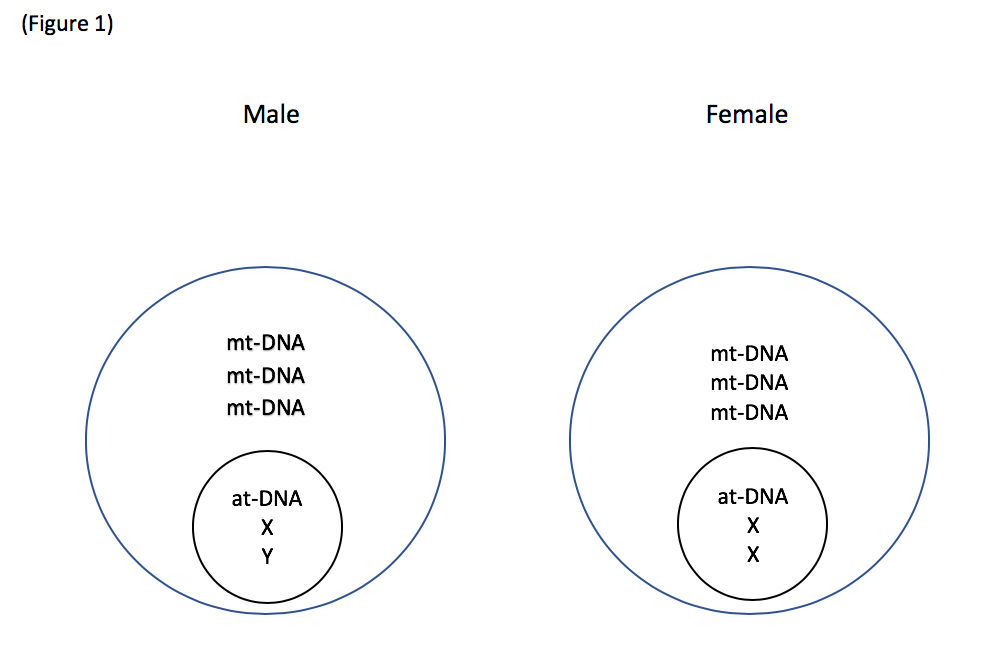
Each large circle represents a human cell. As you can see, the circle inside the cell (called the nucleus) holds the autosomal DNA and the sex chromosomes (X & Y). Floating around inside the cell, but outside of the nucleus, is the mitochondrial DNA.
So why is all this important?
These four types of DNA are inherited in different ways. We use these differences to help us with our genealogy. Let’s take a look at the differences and how we can use them.
mt-DNA: When most things get mixed up in recombination, mt-DNA gets passed from a mother to her children virtually unchanged. This is important because that means a mother’s mt-DNA is essentially the same as her mother’s and her grandmother’s and her great-grandmother going back hundreds of years and maybe a 1,000 years or more. So, if two women share the same direct maternal line, their mt-DNA will match. This is used to help us identify maternal ancestors.
(Figure 2)
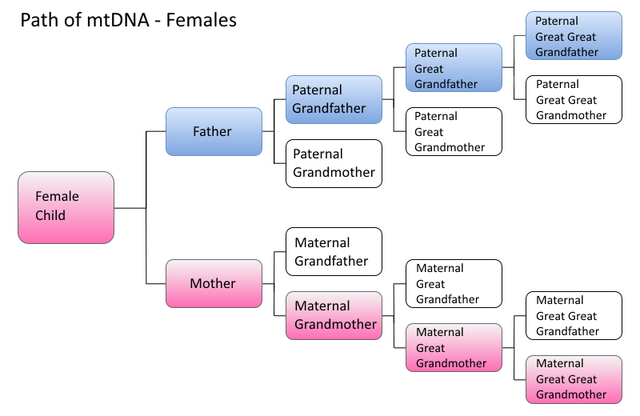
The pink boxes show the mtDNA inheritance pattern for Females. (It is the same for males)
(Source: ISOGG https://isogg.org/w/index.php?curid=4222)
Y-DNA: Y-DNA is similar to mt-DNA. However, only men have Y-DNA and it is passed virtually unchanged from father to son. In other words, it is similar to mt-DNA in that it doesn’t get mixed up in recombination. This is important because a male will have essentially the same Y-DNA as his direct paternal 3rd great-grandfather. If two men share the same direct paternal line, their Y-DNA will match. This is particularly helpful in identifying distant male ancestors. In Western cultures where males pass down the family surname, Y-DNA can also help identify an adoptee’s biological surname.
(Figure 3)
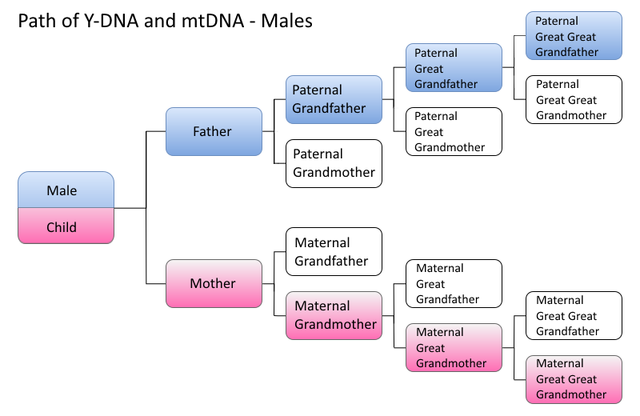
This figure shows the inheritance pattern of Y-DNA (in blue) and mt-DNA (in pink) for males.
(Source: ISOGG https://isogg.org/w/index.php?curid=4223)
at-DNA: Autosomal DNA is a little more complicated because this is the one that gets all mixed up with recombination when it is inherited from our parents. Like the 22 colors of jellybeans, at-DNA is made up of 22 pairs of autosomes. We get 22 from our father and 22 from our mother. This is the most common DNA test offered. It is the only type of DNA test now available at Ancestry.com. at-DNA is very good at helping us identify close relatives. The closer the relative, the easier it is to identify the relationship. On the other hand, because of recombination, the more distant the relative, the less likely we are to end up with some of that relative’s DNA. Once we get past 4-5 generations, at-DNA can be less predictable and harder to use for identifying ancestors. To determine how closely related two people are, genealogists look at the total amount of at-DNA shared (usually expressed in centimorgans “cM”) and the number of shared “segments” along those 22 pairs of autosomes. See figures 4 and 5.
(Figure 4)
Example of a DNA Match list on Ancestry.com
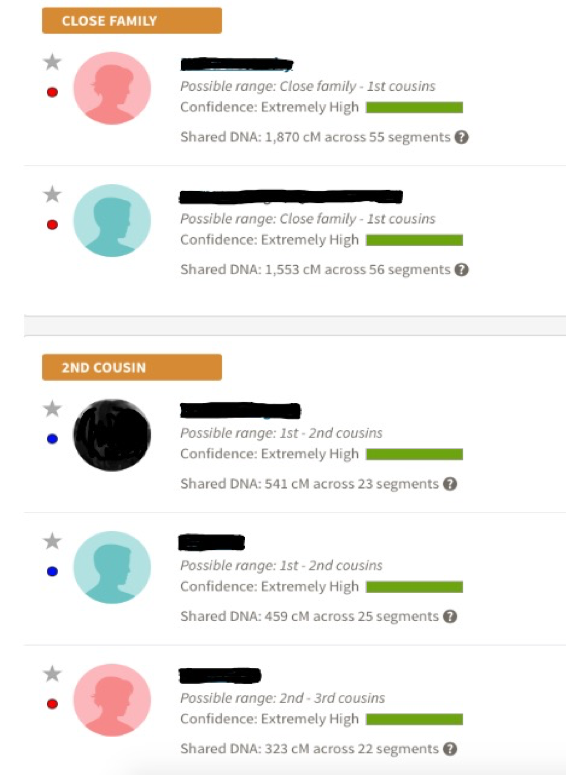
The names are redacted for privacy purposes. Note how the total number of centimorgans (cM) and segments for each match are shown. Typically, the bigger the numbers, the closer the match.
(Figure 5)
Chromosome Browser
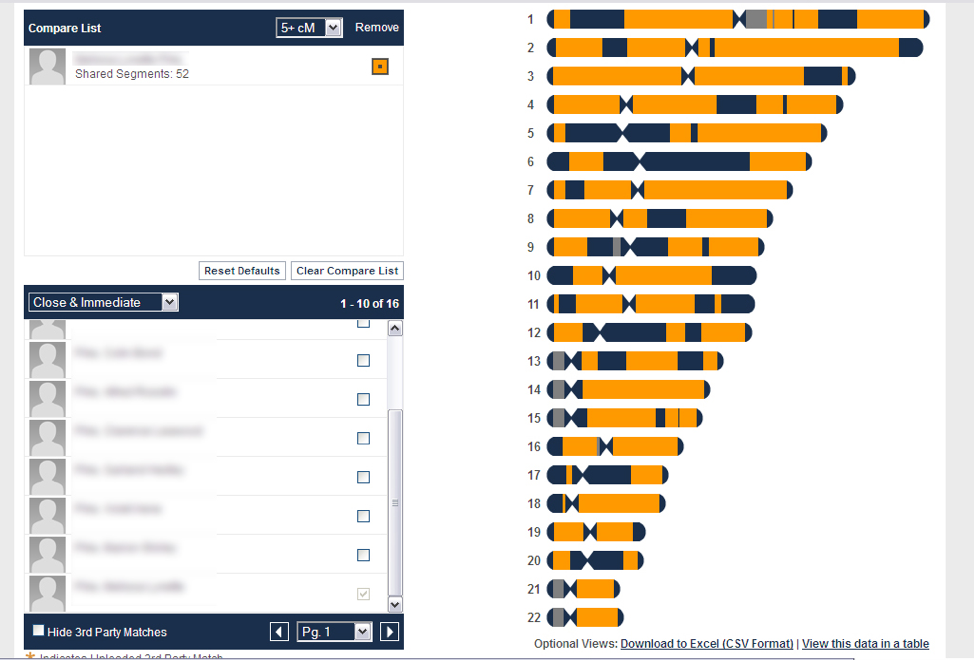
This is an example of how the 22 Chromosomes are displayed at Family Tree DNA. The orange area shows where the test taker and sibling match.
(Source: ISOGG: https://isogg.org/w/index.php?curid=2010)
X-DNA: When you get an at-DNA test, it usually includes the X-DNA information, so you don’t need a separate test for X-DNA. The X chromosome is inherited in a different way than the others. Males have an X and a Y chromosome. He gets the X from his mother and the Y from his father. Females cannot inherit the Y chromosome, so they have 2 X chromosomes (one from the father and one from the mother). Since a father only has one X chromosome, he passes it down to his daughter unchanged. Fathers do not pass X chromosomes to their sons. Since a woman has two X chromosomes (one that she received from her father and one from her mother) the X that she passes to each of her children can be a mix of her two X chromosomes (recombination) or it could be an X passed unchanged. Because of the different way an X chromosome is passed down, it create a unique inheritance pattern (see Figures 6 & 7). This is very helpful in genealogy. If a male matches someone else on the X chromosome, he knows that person is a relative from his mother’s side of the family (because he gets his X-DNA from his mother). For females, it is a little more complicated, but the inheritance pattern is unique enough to also help pinpoint where a match is coming from.
(Figure 6)
X-DNA Inheritance Chart – Males
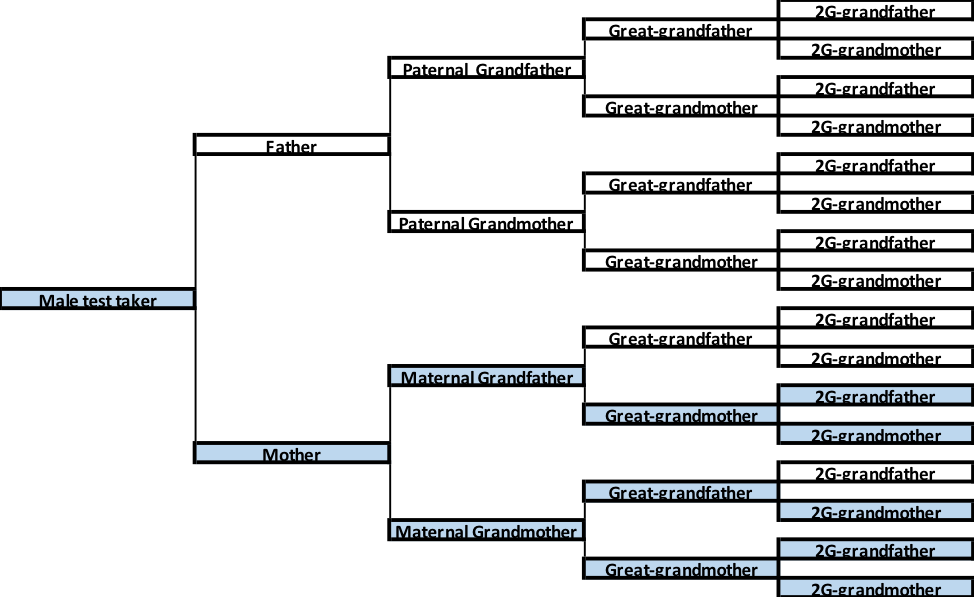
Note that men only inherit the X chromosome from their mother’s side. While this is the area men may inherit X-DNA, the greater the relationship distance, the greater the chance the test taker will not receive an ancestor’s X-DNA.
(Figure 7)
X-DNA Inheritance Chart – Females
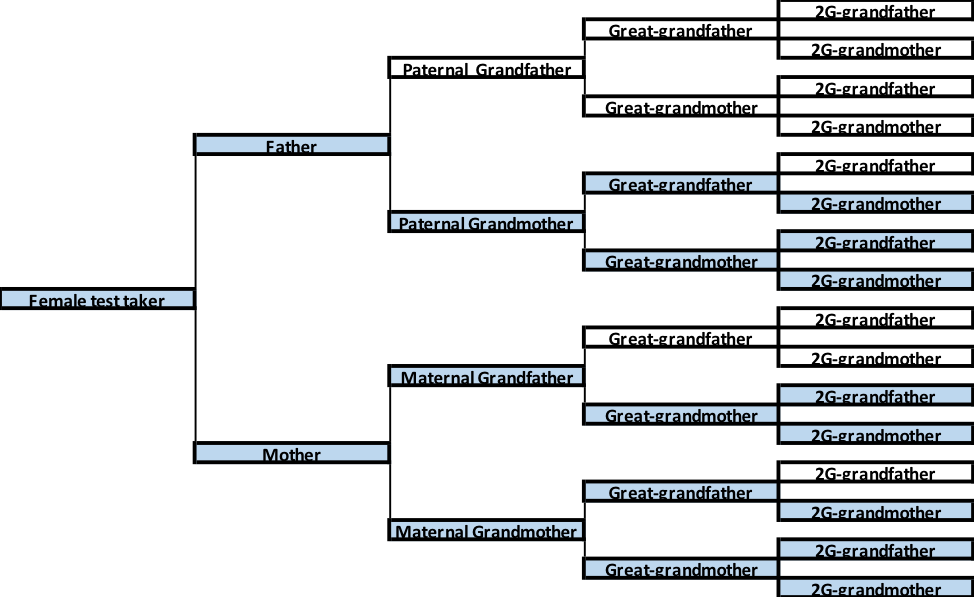
As you can see, women receive an X chromosome from both their fathers and their mothers. However, men can only receive them from their mothers.
Testing –
As mentioned before, a test taken at AncestryDNA is an autosomal test. When the results come in, Ancestry will provide a usually long list of “Matches”. Since at-DNA is a mix of DNA from both parents, the matches could be on either side of the family. While you may recognize a match if it is someone you know (keep in mind that most people use initials or non-identifying names for privacy reasons), the side of the family that match comes from and the exact relationship of that match may not be immediately known. While the X chromosome is part of an at-DNA test, Ancestry does not currently show that information in test result. You can, however, download your Ancestry test data and transfer it to other third party organizations that can give X-DNA information.
When a test is taken at 23andMe, it is also an autosomal test. In this case though, test takers received both autosomal information and X chromosome information with their “matches.”
Family Tree DNA is somewhat different in that the company offers all three types of tests. Mitochondrial testing, Y-DNA tests and autosomal tests (called “Family Finder”). At Family Tree DNA, X information is provided with the autosomal test.
While DNA is a wonderful source for Genealogist, it is only one source, much like a census record or birth record. DNA is of little help to us if we don’t know the people we match and how they relate to the people in our own family tree. This is why DNA must work with documentational research to give a complete picture. DNA can be a great starting point for exploring family history.
The International Society of Genetic Genealogy (ISOGG) https://isogg.org/ offers a regularly updated comparison chart of the major DNA testing services for genealogy. Membership is free and it is also an excellent source of information for both beginners and those experienced in Genetic Genealogy. This link is to that chart: https://isogg.org/wiki/Autosomal_DNA_testing_comparison_chart
The images provided from ISOGG are in accordance with the following creative commons license: https://creativecommons.org/licenses/by-nc-sa/3.0/legalcode
